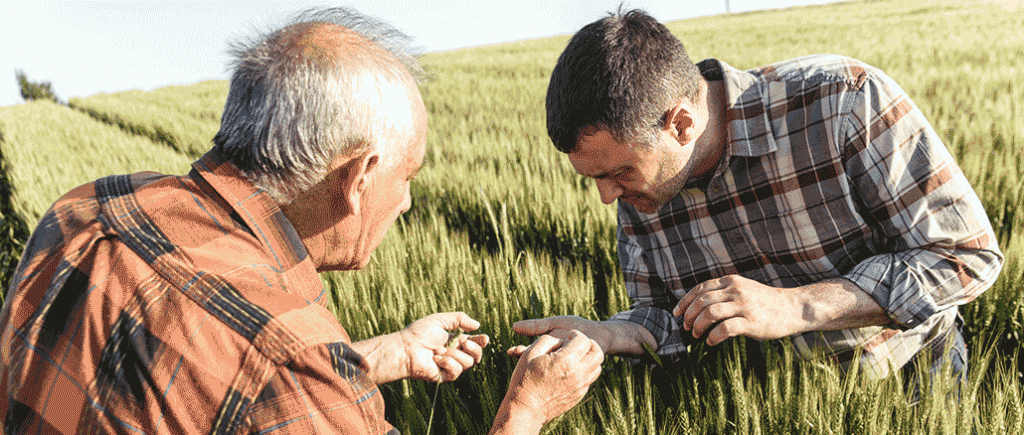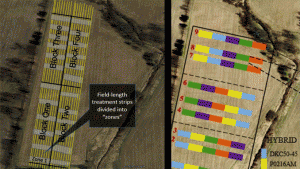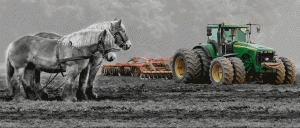Understanding precision agriculture
THE CHALLENGES OF ON-FARM PRECISION AG RESEARCH

YOU CAN BUY the equipment and software, bring on a consultant and start banking yield data, but what can you do once you’re up and running to ensure you’re getting useful information from your on-farm precision ag trials that will help you better manage your fields?
This article will look at a few challenges and potential pitfalls growers and applied researchers can face when doing on-farm seed population and variable rate nitrogen trials as part of the three-year Precision Agriculture Advancement for Ontario (PAAO) project.
THE FARMER’S PERSPECTIVE
Nobody ever said that moving over to precision farming was something you walk into over one season. And if you talk to Brent Vanden Bosch, building up a successful precision agriculture project comes from strong crop consultant partnerships, patience, and a willingness to sweat the small details to learn more about your fields year after year.
Vanden Bosch farms corn, soybeans, and winter wheat in Chesterville, Ontario, and has been working with the PAAO researchers over the past three seasons on seed population and nitrogen trials.
“Right off the bat, one of the things you want to get hooked up with is a good crop consultant that has some history with you,” he says. “But you also need to have a strong knowledge of your fields and an idea of what your soils are and the shape they’re in.”
He says that one of the main challenges he’s faced this season with his nitrogen rate and seed population trials has been wet weather.
Vanden Bosch’s area received around seven inches of rain in the month of May, which caused him to switch from a 98-day corn variety down to a 91-day variety.
“We already know that we’re going to lose some spots in that field because of flooding — but it’s just an area of the field that has 50 feet of fall in it from one end to the other,” he says. “When wet weather and drainage become problems, you can run into issues where you’re switching varieties or even changing populations.”
Other potential obstacles to pulling off successful precision ag trials are time and cost. Tests, such as grid soil sampling, can add up — especially when covering multiple fields. Plus, gathering useful data isn’t something that can be sped up.
“It’s a slow thing to work at, but you need to get enough quality data so that you feel confident you’re making good choices year over year,” says Vanden Bosch.
THE RESEARCHER’S PERSPECTIVE
Ian McDonald, applied research coordinator for the field crops unit of the Ontario Ministry of Agriculture, Food and Rural Affairs (OMAFRA), says that one of the biggest challenges stems from setting up proper validation strips for variable seed and nitrogen rate trials.
“The issue many growers run into is that the seed or nitrogen rates they want to choose for their validation strips are rates they think they’re trying to target for the whole management zone,” says McDonald.
In a corn seed population trial, for example, the main target might be 32,000 seeds per acre for a management zone. For their validation strips, the seeding rates should be 4,000 or 5,000 seeds per acre higher and lower.
Likewise, for nitrogen, if the target rate is 150 pounds per acre, McDonald will see some growers apply 125 pounds per acre for the low check and 175 pounds per acre for the high check. But neither the high or low rates are different enough to help tease out the management zone’s actual rate. Instead, growers should aim for at least a 50 pound-per-acre separation between their low, normal, and high nitrogen rates.
“Proper validation is all about determining what the right rate should have been,” he explains. “Having that proper separation between your nitrogen and seed population rates will eventually lead you to the right answer as you look at the yield response over several seasons.”
Another set of challenges, says McDonald, can arise as precision ag projects get more and more complex with each passing season.
“I suppose the question is, how do you keep all your various trials and data layers straight and sort out what the return on investment for each of these components is,” he says.
McDonald points out that the first year of a precision agriculture project is generally more straightforward, as growers compare the performance of their trials to whole-field management.
“But in the seasons that follow when growers implement site-specific management and continue to add data layers, how do they get past the confusion?” asks McDonald. “That’s something we’re working to figure out — how to deal with complex projects and then find ways to validate which of their decisions had a positive or negative impact.”
For Vanden Bosch, keeping tabs on his variable seed and nitrogen rate trials involves having a strong knowledge of his fields, working with his crop consultant and then looking at each layer, such as soil nutrient levels or elevation data, as interconnected pieces.
“You might see that you have a drainage issue that’s causing problems in one part of the field, or start looking at your P and K levels and see your soil pH is way off,” he explains. “But once you sit down and start getting all these layers together, things really come together and make sense.”
This project was funded in part through Growing Forward 2 (GF2), a federal-provincial-territorial initiative. The Agricultural Adaptation Council assists in the delivery of GF2 in Ontario. •












